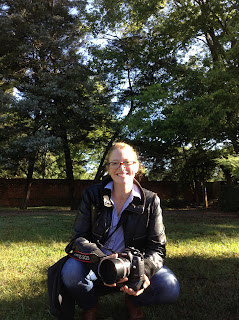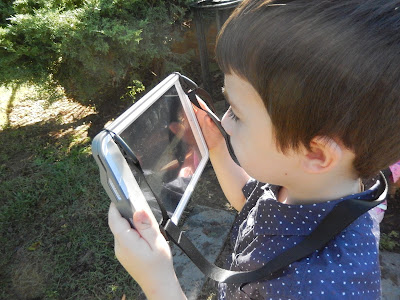 |
Loose materials collage; one way children
tell us what they are thinking |
Children have the right to be listened to. Really listened to. Not just during a conflict, or when someone is hurt or upset, but all the time. As adults living in a world with children, we must read between the lines, consider the deeper meaning to what is said or shown us. We owe this attention to the youngest members of our world. This deep listening and contemplation is necessary for mutual connection and understanding.
Words are not always used; children utilize many ways to communicate with the other humans around them. While as adults we are used to spoken communication, children express themselves through many
languages, not just the talking kind. Expressive movement, block construction, food science, clay sculpture, dramatic play, natural material collage- all are vehicles for expressing one's inner thoughts, feelings, and conflicts. By providing the space, time, and open-ended materials for this self-expression, we learn about the child as an individual with interests, proclivities, fears, ideas, and opinions.
 |
Ila's forest for the snails and worms;
one of the knotty questions we
are noticing: what is a forest? |
Behavior gives us a great deal of information, too. As teachers, we closely watch the engagement with the classroom materials, or the emergence of common threads during play and investigation. Big ideas surface over and over again, telling us there's a knotty question being explored. We ask ourselves,
what is important to the children about this type of play? What are they trying to say through these materials and/or these actions? What materials or opportunities can we provide that will support further investigation or deeper engagement? What seems to be working in the classroom and what needs to be tweaked?
Since the beginning of our school year, we have included a "morning meeting" as part of our classroom routine. This early circle time provided us the opportunity to share information, to allow for children to show their work and share their thinking, and to explore some big ideas or questions that have surfaced in the work of the classroom. My co-teacher Lisa and I were feeling pretty strongly that this time was valuably used- after all, this time was perfect for co-constructing as a group and for planning the rest of our morning. We also saw the value in practicing a large group activity to prepare for the expectations of kindergarten, where our children will be going next year.
However, the morning meeting started to fall apart as the weeks progressed. Clearly our children were more interested in each other than in the topic of discussion. Lisa and I had to put on our thinking caps to address this challenge: we
knew we were reflecting their own ideas back to them, so why the disinterest? Why all the giggling and side conversations? Why were children laying down on the carpet and telling us that circle was boring?
 |
John made this card depicting
two people talking during
morning meeting. |
So we brought a question to the children:
how can we get your attention during morning meeting?
Many suggestions were generated, from sign-language, to clapping....and then Pierce proposed using cards, or signs, to throw on the carpet when someone notices someone else not paying attention. This idea put the onus on the children to monitor each other, not just the teachers. Everyone agreed. So we made cards for everyone to use during circle.
Problem solved? Well, not exactly. We tried the cards for a couple of days. They worked for a little while, but the distraction in circle continued. What was going on here?
Lisa and I put our heads together again. We could continue to bring this problem back to the children, or we could really listen to what was being demonstrated to us: morning meeting was the problem. Notice my earlier question did not really capture the essence of the issue. I should have asked,
what feels hard about morning meeting? I suspect the answers would be pretty clear:
we want to play and spend time with our friends. I have more clarity now, but in the moment my earlier question felt appropriate.
 |
One of the cards Pierce created
for morning meeting. |
So we let go of our morning meeting, in our minds only temporarily. And the engagement of small groups of children increased. We observed productive play, investigation, and connection.
Older 4s and 5s are really socially motivated people. There's a strong need to connect to one's friends. This connecting
is the hard work of early childhood. It trumps anything put before it, like morning meeting. We realized that our students had no time to feel connected to each other: we were scheduling our morning meeting right after hand-washing, signing-in, and observational drawing. It's not a question of
should we have a large group meeting, it's a question of
when to have it. So now we are having one at the end of the morning, before dismissal. And there's a much better vibe!
 |
| Children playing ghostbusters first thing in the morning |
Will we every have a morning meeting? We hope so- we'll try again in January. But we'll be listening and taking feedback. As for the knotty questions that emerge, we can discuss them in small groups, or wait until the later circle. Our classroom work is still rich and provocative.









